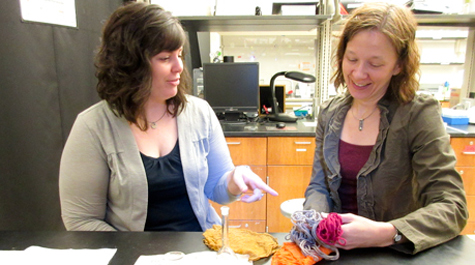What if we told you that you have been doing organic chemistry all semester?
Elizabeth Harbron and Kristin Wustholz both are color specialists in William & Mary’s Department of Chemistry, so it’s natural that they would collaborate to produce a new course they’ve titled Color, Light, & Chemistry.
Chem 201 is a course for non-science majors: “The first thing we did was kick out all the chem majors,” Harbron says with a grin. They launched the course in spring of 2017, with Harbron teaching the inaugural semester. Wustholz will teach it in the fall, but has kept a close eye on Chem 201’s maiden voyage with Harbron at the helm.
As the academic year ends, both Harbron and Wustholz say they’re happy with Color, Light, & Chemistry. Each chemist prefaces her remarks with the traditional professor’s disclaimer of “Even though the course evaluations aren’t in yet...” Once they’ve made that nod to the slings and arrows of outrageous fortune so often embedded in student appraisals of a class section, the chemists are willing to say that the class seemed to like Color, Light, & Chemistry.
Color, Light, & Chemistry is a COLL course, a special offering in the second year of the university’s College Curriculum. Second-year, 200-level, COLL courses build on the foundation of exploration of methods of inquiry. The chemistry majors were booted because they would need to take a different COLL 200-level course, one that would complement and add to the modes of knowing they’ve accumulated as they proceed through a STEM major.
The absence of chemistry majors allowed Harbron and Wustholz to sneak quite a bit of organic chemistry into the course without alarming the students, who were no doubt beneficiaries of dorm-room horror stories about the rigors of “Orgo” from their STEM-major colleagues. The students did well; their professors were not surprised.
“If they don’t know they’re doing organic chemistry, they’re not afraid of it,” Harbron, an associate professor, said.
Color, Light, & Chemistry has a significant hands-on component as well, drawing from the research activities of both Harbron and Wustholz. The Wustholz lab is one of the world’s foremost facilities for identifying pigments from historic paintings and other artifacts. Harbron works with a variety of molecules that fluoresce or change color under stimulus.
The two chemists drew on their own research activities to put together a more colorful set of exercises to replace the typical achromatic organic chemistry lab procedures that Harbron describes as “taking white powder A and reacting it with clear reagent B to produce white powder C.”
“A big aspect of the class is getting our hands on artists’ materials and then trying to understand the chemistry of those materials,” Wustholz explained.
One such activity is the preparation of carmine lake pigments, a process that Wustholz summarized as “grinding up bugs and making paint.” Those bugs are cochineal insects, which have been used to make pigments for millennia. The bugs can be mortared-and-pestled into a powder that creates a nice, deep red, but not for long. It fades, becoming what art professionals know as a “fugitive” pigment — gone, but not beyond the reach of chemistry. The Chem 201 students learn about the nature of fugitive pigments directly, creating an original painting from their hand-ground cochineal bugs.
“Then they intentionally fade the pigments, to watch this fugitive fading process occur,” said Wustholz, an assistant professor in the department.
It was just a matter of time until the students Chem 201 learned the true nature of the seemingly innocent bonds and reactions that made up their homework. The revelations came one by one, Harbron said. In one case, a teaching assistant in a section of Chem 209 — Organic Chemistry, happened to glance at a friend’s work in progress.
“Do you know what this is?” the surprised TA asked.
“Yeah, it’s homework for Color, Light, & Chemistry, my COLL 200 course.”
“Well, OK. But this stuff is actually what you do when you take Organic Chemistry.”
“No!” Skip to main content
Skip to main content

